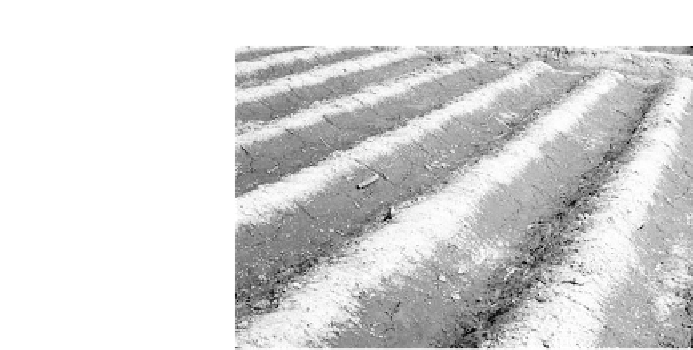Agriculture Reference
In-Depth Information
Figure
10.21.
Field showing salt accumulation.
There are three types of irrigation systems found in nearly all parts of the world:
surface, sprinkler, and drip. The most common is Surface irrigation. Examples are
rice paddies. Sprinkler is normally an expensive type of system and most commonly
found on high value crops in industrialized countries. Drip irrigation is the most effi-
cient type of system used for high value crops. Each type of irrigation system can
use water from any source.
10.15.1 Surface Irrigation
Surface irrigation includes irrigation by furrows, one of the most common irrigation
methods. The basic system is one of using smaller and smaller canals until the water
ends up in a small furrow between plants in the field. An advantage of furrow irrigation
is that it is the cheapest to install, but it is also one of the most difficult to install prop-
erly. The most important requirement is that each section of canal and furrow must have
a uniform slope. As with rice paddies, land leveling is essential. Even in rice paddies the
field must have some slope to permit drainage in preparation for harvest. Fields irri-
gated by furrows must have slightly more slope to keep the water flowing. Even
though the furrows in Figure 10.22 appear to be flat, they actually have a slight
slope toward the bottom of the figure. This permits the farmer to fill the furrow with
water quickly and move on to the next. The result is a uniform application of water
and all plants in the field receive the right amount. If the furrows are not uniformly
sloped, there will be wet and dry spots with overall losses in yields.
A disadvantage of surface irrigation is that the farmer must be present to manage
the water. If too much water is let into the furrows, it will build up and spill over into
other fields, causing erosion and loss of valuable water. If not enough is put on the field,
another irrigation will be needed too soon.
10.15.2 Sprinkler Irrigation
Sprinkler irrigation consists of spraying water into the air to simulate natural rainfall.
When properly done, it will distribute a uniform amount of water over a crop with








